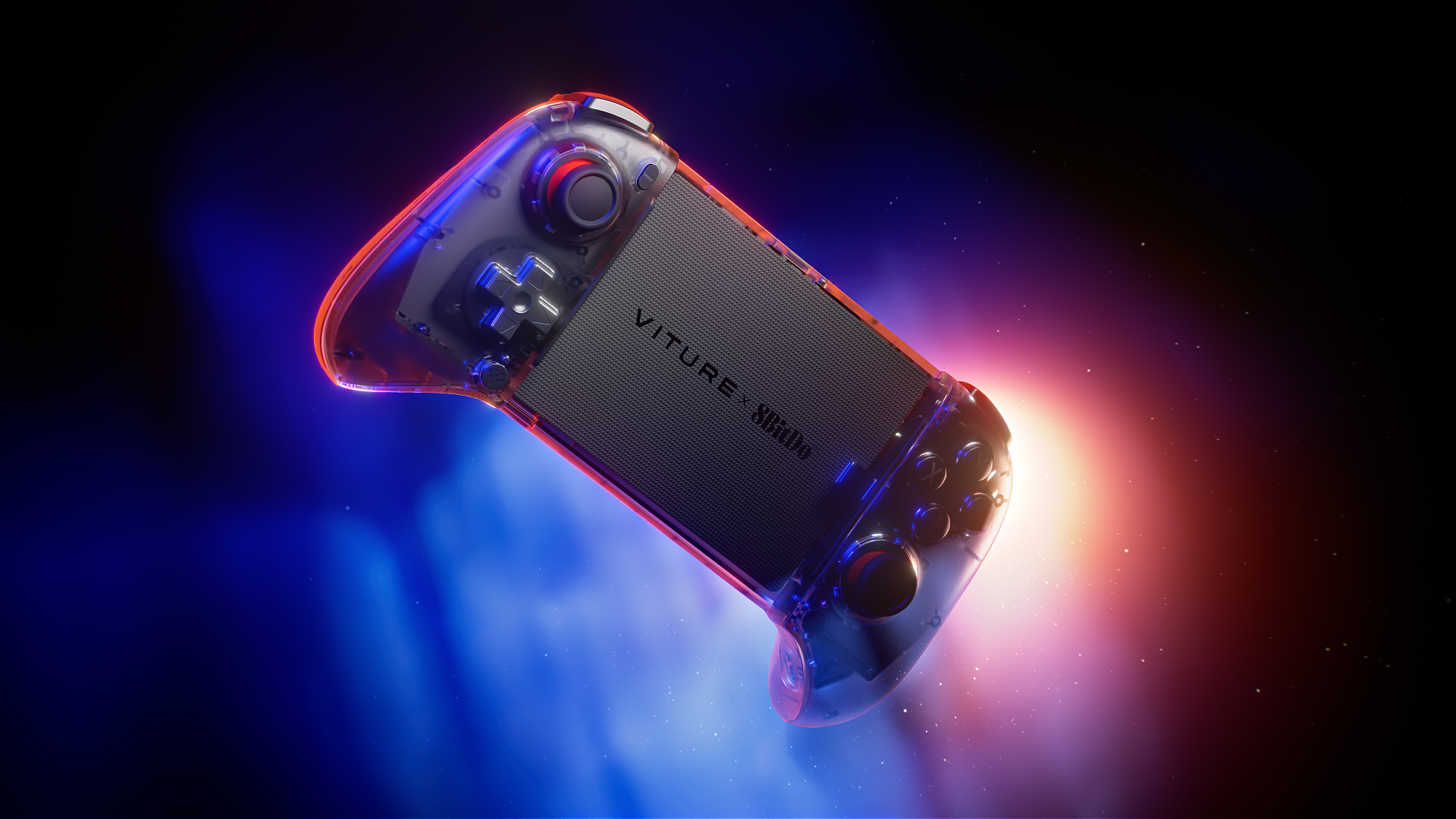Laptop Mag Verdict
The Lenovo Y40 offers solid gaming performance in a sexy and light design, as well as long battery life, but the screen doesn't pop.
Pros
- +
Sleek and lightweight chassis
- +
Solid graphics and overall performance
- +
Long battery life
- +
Strong speakers
Cons
- -
Shallow keyboard
- -
Dull display with shallow viewing angles
- -
Slow SSD
Why you can trust Laptop Mag
How much portable gaming laptop can you get for less than a grand? Lenovo thinks it has the best answer yet with the Y40. Priced at $949 (starting at $749), this sleek and stylish notebook has long battery life and an AMD Radeon R9 graphics card for playing the latest titles. However, the lower-tier GPU forced me to settle for less-than-blistering frame rates, and the screen doesn't wow.
Design
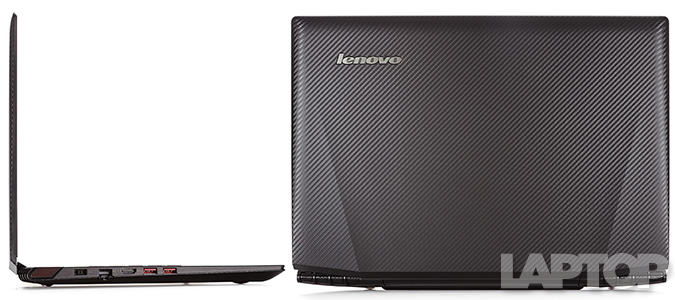
The textured feel against my fingertips, the way the light undulates across the surface -- faux carbon-fiber chassis, you complete me. A pair of distinct, yet subtle lines that gradually recede into the top of the Y40's lid reminds me of a car hood; I love that it provides the feeling of peeling down a straightaway. There's not much flourish, but the glossy, dark-gray plastic Lenovo logo is a nice touch.
While the Y40's textured finish is lovely, the Razer Blade 14 remains my favorite 14-inch notebook in terms of design. The inky-black aluminum chassis manages to be striking yet subtle.
MORE: Find the Best Gaming Laptop for You
Upon opening the notebook, a layout similar to the larger Y50 greeted me. The majority of the deck is made of cool-to-the-touch, black brushed aluminum. The top of the deck is wrapped in shiny, black plastic flanked on either side by a black metal speaker grille with a red underlay. Buttons for power and Lenovo OneKey Recovery sit next to the right-side speaker.
At 4.4 pounds, the Y40 is fairly light, matching the Razer Blade 14 (2014). However the Blade 14 continues to be one of the slimmest in the land, measuring 13.6 x 9.3 x 0.7 inches, which is smaller than the Y40's 13.7 x 9.9 x 0.9-inch chassis. The MSI GS60 Ghost (4.2 pounds, 15.4 x 10.5 x 0.78 inches) is also lighter and thinner.
Display
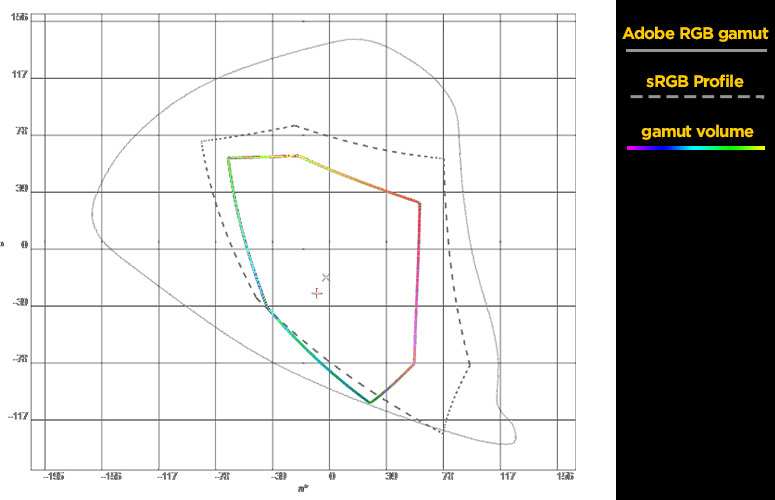
Click to EnlargeSadly for a multimedia and gaming notebook, the Y40's 14-inch, 1920 x 1080-pixel anti-glare screen doesn't deliver the entertainment value I'd expect. According to our measurements, the panel is capable of displaying only 58.5 percent of the sRGB color gamut, which is well below the 86.4 percent thin-and-light average. The GS60 managed 98 percent, while the Blade 14 hit an impressive 101.5 percent.
On the Delta-E color accuracy test, the Y40 scored 8.8, which is far from a perfect 0. The Blade 14 came the closest to that mark at 1.5, while the GS60 scored 2.9.
Those underwhelming results help explain why colors fizzled on the Y40's display. The 1080p trailer for JIMI: All Is By My Side, which should have been an explosion of color, was lackluster at best. Andre 3000's skin looked washed out, while Hayley Atwell's red hair looked flat and lifeless. Viewing angles were monstrously shallow, with colors inverting at viewing angles of more than 45 degrees.
Things improved somewhat once I started gaming, as the deep greens, magentas and electric blues practically leapt off the panel as I played Borderlands 2. I particularly enjoyed watching enemies taking continuous damage from the bright-green radioactive goo that I shot at them. However, contrast was lacking in Metro: Last Light, as the Moscow subway system was a muddle of grays and blacks.
What the Y40 lacks in color and viewing angles, it makes up for in detail. I could see every wispy curl of Jimi's whimsical hairdo, along with the fine curlicues in his silk paisley shirt.
The laptop's display measured 200 nits on our light meter, falling short of the 216-nit average. The Blade 14 hit 260 nits, while the GS60 Ghost delivered a dazzling 299 nits.
Audio
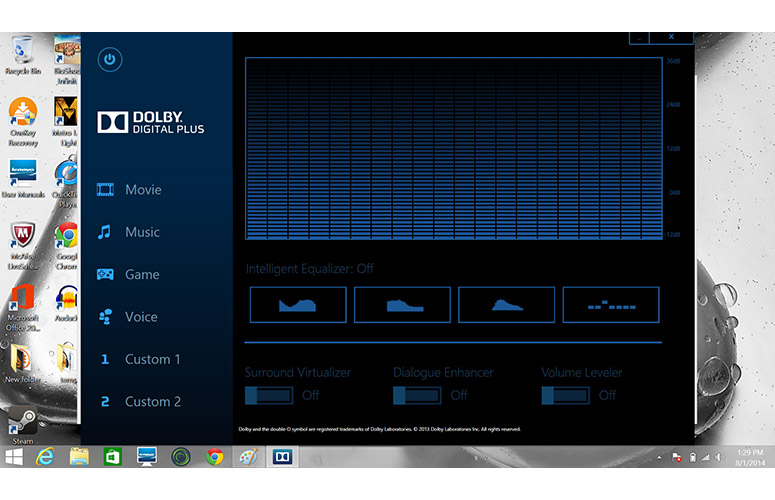
Click to EnlargeThe Y40's JBL speakers pumped out big sound. Augmented by Dolby Digital Plus software, the pair of red-and-black speakers filled my small test room with crisp, punchy audio. Rosie Gaines' sophisticated alto in "I Can't Get You Outta My Mind" soared against the thumping bass line and crisp keyboard.
When measured for volume, the Y40 matched the thin-and-light average of 82 decibels. The GS60 was slightly louder, at 84 dB, but the Blade reached a higher 88 dB.
Keyboard and Touchpad
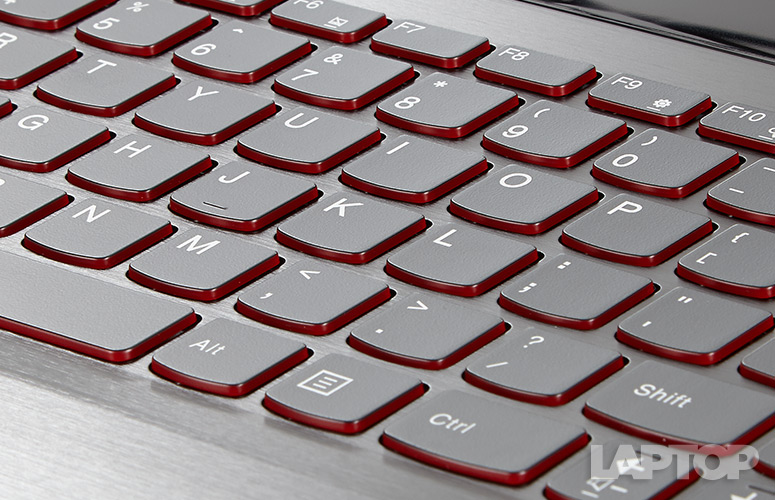
Click to EnlargeIt seems that the keyboard gods have forsaken Lenovo. The red-rimmed keys on the Y40's island-style keyboard have 1.3 mm of travel, falling short of the desired 1.5 to 2 mm range. I would normally overlook this drawback on a regular thin-and-light laptop, but not one targeting gamers.
In practice, the keys felt shallow, and some -- such as the Backspace and right Shift keys -- are undersized, making typing a chore. I eked out a paltry 46 words per minute on the Ten Thumbs Typing Test, which is well below my usual 55 wpm.
I was disappointed to learn that the Y40 lacked the backlighting found on the Y50's keyboard. The keyboard looks good, but aesthetics don't help when you're playing in a dimly lit setting.
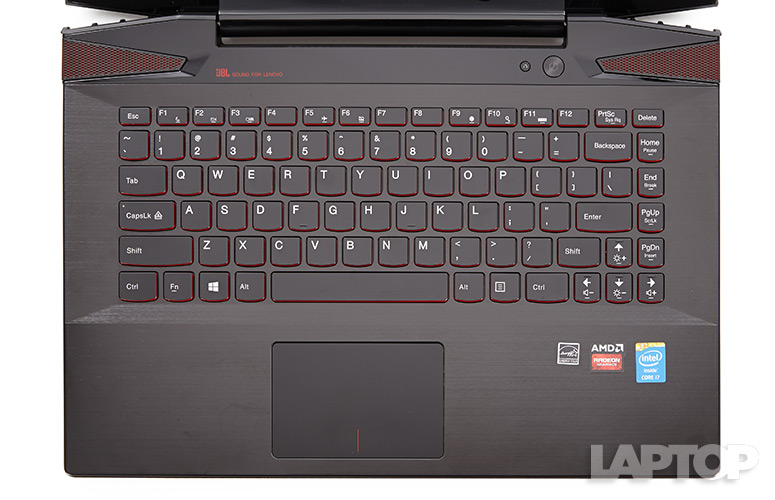
Click to EnlargeI was happy to see that the Y40's 3.5 x 2.4-inch Elan touchpad provided a much better experience than the Y50. I typed without fear that my palm would accidentally graze the touchpad and launch a Windows 8 function.
I effortlessly performed such gestures as pinch-zoom, cycling between apps and two-finger rotate. The touchpad's bottom corners delivered firm feedback and served well as left and right mouse buttons.
MORE: The Best Gaming Keyboards You Can Buy
Heat
The Y40 is a cool customer, hitting only 81 degrees on the touchpad after I streamed a full-screen Hulu video for 15 minutes. That's much lower than our 95-degree comfort threshold. The space between the G and H keys registered 88 degrees, while the laptop's undercarriage was 87 degrees.
When I played Half-Life 2 for 15 minutes, the Y40's temperature rose considerably. The touchpad jumped to 90 degrees, while the space between the G and H keys measured 94 degrees. The bottom of the notebook hit 99 degrees. However, I used this system comfortably in my lap for more than 2 hours.
Webcam
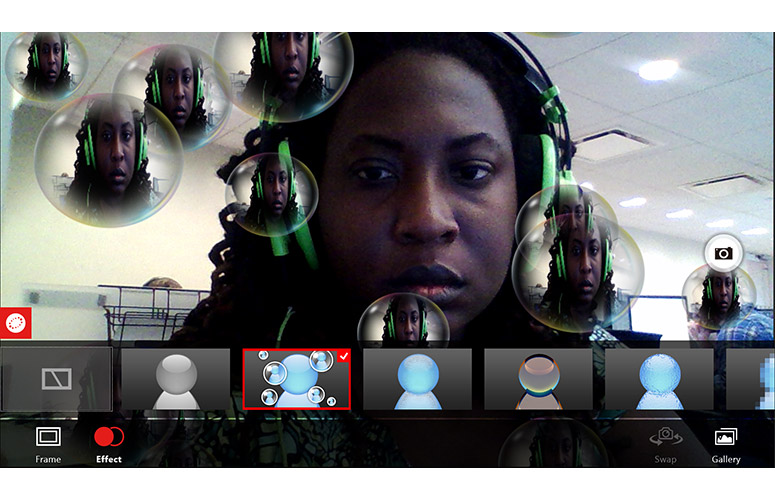
Click to EnlargeIf you're looking for vibrant hues and crisp detail, keep looking. Photos taken with Y40's integrated 720p camera were relatively dark and full of visual noise. My normally eye-catching neon-green AKG Q701 headphones looked faded, as did the myriad shades of green in my shirt. My curled locks lacked definition, and looked more like blurry blobs.
At least you can have a little fun with your pics. Lenovo's Camera Man software lets you add different effects and filters, such as particles and distortion mirrors. My favorite option was the bubble effect that placed my image in a series of floating bubbles.
Ports
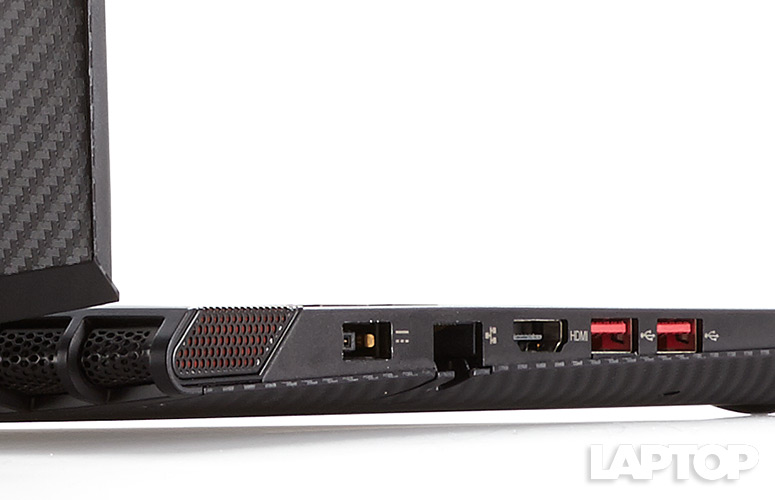
Click to EnlargeFor such a slim gaming laptop, the Y40 has a lot of ports. There's a single USB 2.0 port on the right with a 4-in-1 card reader, a combination headphone/microphone jack, a S/PDIF jack and a secure lock slot. The left side of the notebook has a pair of USB 3.0 ports, an HDMI port, an expandable Gigabit Ethernet slot and a proprietary power port.
Gaming and Graphics
Outfitted with the AMD Radeon R9 M275 GPU with 2GB of VRAM, the Lenovo Y40 offers decent graphics performance for the money. You'll be able to play demanding games such as BioShock Infinite and Titanfall -- just not at the highest settings.
Borderlands 2 ran smoothly on low at 1080p, but it exhibited some lag when I cranked it up to Maximum. It was more annoying than game-breaking, but there were a few occasions when an enemy got the drop on me due to a slow-moving reticle.
The laptop is also equipped with an Intel HD Graphics GPU to handle the light stuff like streaming video.
On the BioShock Infinite benchmark, the Y40 scored 38 frames per second on Low at 1080p, below the 53 fps average. The Razer Blade 14 hit a whopping 120 fps, while the MSI Ghost GS60 averaged 91 fps. To be fair, both the Blade and Ghost cost a much higher $2,399 and $1,799, respectively, and feature more powerful Nvidia GPUs.
MORE: 8 Essential Tips for Your New Windows 8 PC
On maximum settings playing the same game, the Y40's frame rate fell to 14 fps, missing the 21 fps category average. The Ghost obtained 35 fps, while the Blade 14 asserted its dominance at 65 fps.
On the 3DMark Ice Storm Unlimited benchmark, which also tests graphics performance, the Y40 hit 83,508. That was enough to topple the 60,275 thin-and-light average but not the Ghost (113,571) or Blade 14 (113,793).
Performance
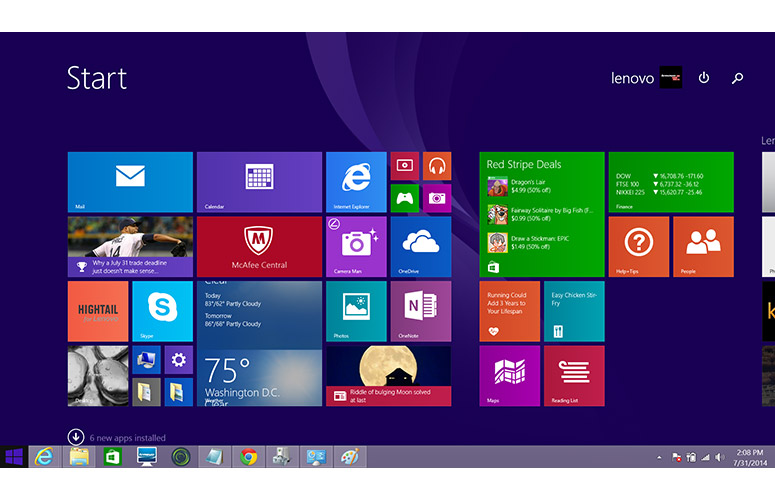
Click to EnlargeBeneath the Lenovo Y40's stylish exterior lurk the capable components of a digital workhorse. The laptop's 1.8-GHz Intel Core i7-4500U CPU with 8GB of RAM ably streamed an episode of The Boondocks on Netflix with eight open windows in Google Chrome while performing a full system scan.
During Geekbench 3, which measures overall performance, the Y40 scored 5,537, missing the 5,823 thin-and-light average. The 2.4-GHz Intel Core i7-4700HQ-powered MSI GS60 Ghost notched 12,695, while the Razer Blade 14 and its 2.2-GHz Intel Core i7-4702HQ CPU obtained 11,497.
On the File Transfer Test, the Y40's Lite-On 256GB SSD duplicated 4.97GB of multimedia files in 2 minutes and 10 seconds, for a transfer rate of 39.1 MBps. That's well below the 107.2 MBps average, and very slow for an SSD.
When the Y40 ran the spreadsheet performance test, it paired 20,000 names and addresses in 4 minutes and 33 seconds. That's nearly 2 minutes faster than the 6:23 average.
Battery Life
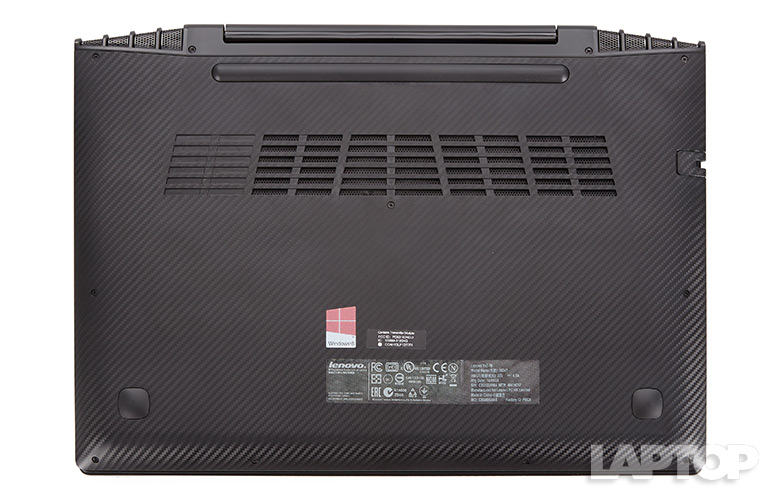
Click to EnlargeOne area where the Lenovo Y40 bested its more expensive counterparts is in the endurance department. On the Laptop Mag Battery Test (continuous Web surfing over Wi-Fi at 100 nits), the Y40 lasted 7 hours and 34 minutes, matching the thin-and-light average. The Blade 14 finished in 5:19, while the GS60 Ghost clocked out at 5:34.
MORE: 10 Laptops with the Longest Battery Life
Software and Warranty
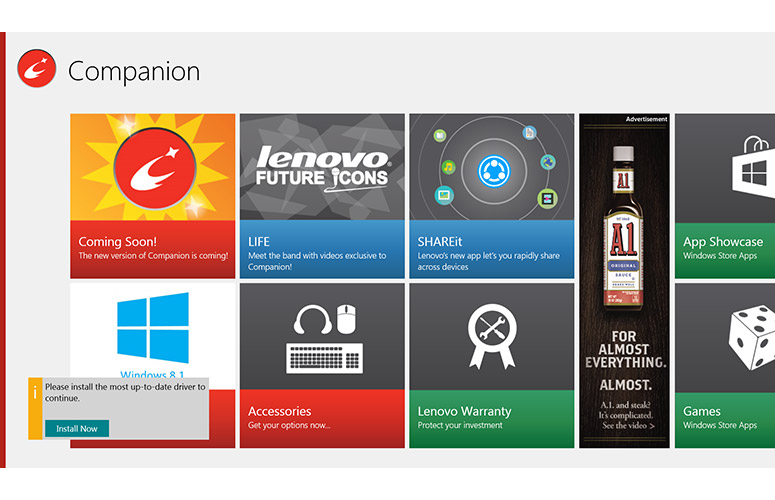
Click to EnlargeLenovo preinstalled a fairly robust suite of utilities, including Lenovo Companion, which has the Getting Started Guide, App Showcase and other helpful links. Lenovo Support provides links to a User Guide, Hints and Tips, Knowledge Base, and Discussion Forum. OneKey Recovery System allows you to create a backup image file of your hard drive in case of a crash. The Settings app compiles important settings (Wi-Fi, Airplane Mode, Microphone, Keyboard LED and Touchpad) into an easy-to-use control panel.
Hoping to attract heavy-multimedia users, the Y40 comes with CyberPower's PhotoDirector 3 and MediaStory software, which let you edit images and create slideshows, respectively.
Even though I wouldn't know my way around a sound mixing board, I had fun creating music with the SoundLight software. Using pre-recorded tracks, including a hip-hop bass line, I cobbled together a danceable ditty. And because sometimes you just gotta sing, Lenovo has also included the Red Karaoke Lenovo app.
Third-party software includes eBay, Accuweather.com, Evernote Touch, Zinio Reader, Kindle and FilmonTV, a streaming channel that features more than 600 channels of live television and movies.
File Sharing
To complement its content-creation software, the Y40 has several file-sharing options for sharing your stuff across several devices. Hightail for Lenovo lets you upload files and folders to the cloud so you can share and access them from anywhere. Exclusive to Lenovo users, Hightail offers 5GB of free storage.
If that isn't enough file-sharing goodness for you, the company offers Lenovo Reach, which includes a file manager, app selector and website manager. Similar to Hightail, Reach can be accessed on any device, including iOS, Android and Windows Phone.
Lenovo's Magic Transfer software lets you transfer files between laptops by dragging and dropping via the touch screen. Once the laptops are connected to a local network, it's a simple flick of the wrist -- at least it would have been if the Y40 had been equipped with a touch screen. Instead, I was relegated to doing it the old-fashioned way, by using the mouse. Still, it took a relatively quick 3 seconds to transfer individual docs and music files.
Lenovo Phone Companion
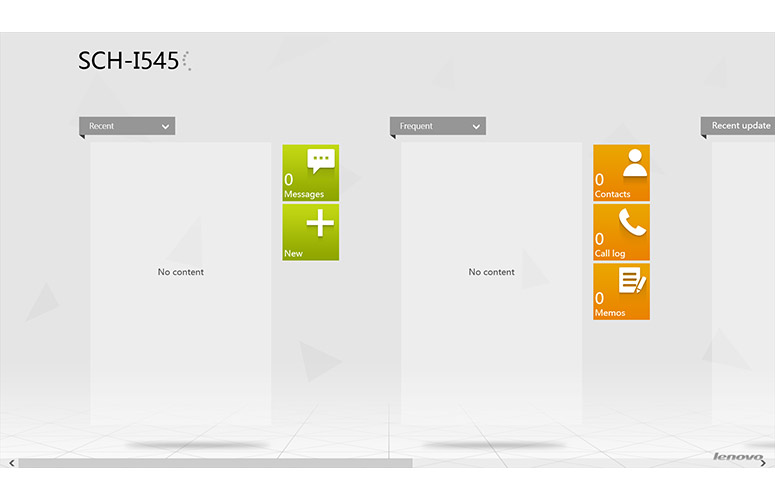
Click to EnlargeSimilar to the Y50, the Y40 features the Phone Companion app (free on Android, iOS and Windows Phone), which syncs the PC with your smartphone over a local network and lets you place calls, send text messages and swap content between the two devices.
However, the setup is rather tedious. After scanning a QR code with my Samsung Galaxy S4 and installing the app, I made sure that the notebook and the S4 were on the same local network.
From there, I hit the Connect button and waited … and waited. About 2 minutes later, the two systems found each other, and it took another 3 minutes to pull up my contacts, pictures, video and call history.
It was pretty straightforward to browse through my contacts and photo gallery. Sending and receiving text was quick, with responses on the PC showing up a few seconds after they hit the phone. While you can place and receive calls on the PC, you still have to use the phone to talk.
Overall, it's a solid concept, but I hope Lenovo plans to just place the app in the app stores instead of making people download QR scanners just to install the program.
Configurations
The Lenovo Y40 I reviewed was configured with a 1.8-GHz Intel Core i7-4500U CPU, which has since been upgraded to a 2-GHz Intel Core i7-4510U processor. The rest of the specs in the $949 device remained the same, including 8GB of RAM, a 256GB SSD, an Intel HD Graphics GPU and an AMD Radeon R9 M275 GPU with 2GB of VRAM.
The $749 base model features a 2-GHz Intel Core i7-4510U, 8GB of RAM and a 500GB, 5,400 RPM hard drive paired with an 8GB SSD. You also get Intel HD Graphics and an AMD Radeon R9 M275 GPU with 2GB of VRAM.
The $1,349 configuration has a 2-GHz Intel Core i7-4510U; 8GB of RAM; a 1TB, 5,400 RPM hard drive with an 8GB SSD; Intel HD Graphics; and an AMD Radeon R9 M275 GPU with 2GB of VRAM.
The Lenovo Y40 comes with a one-year parts-and-labor warranty.
Bottom Line
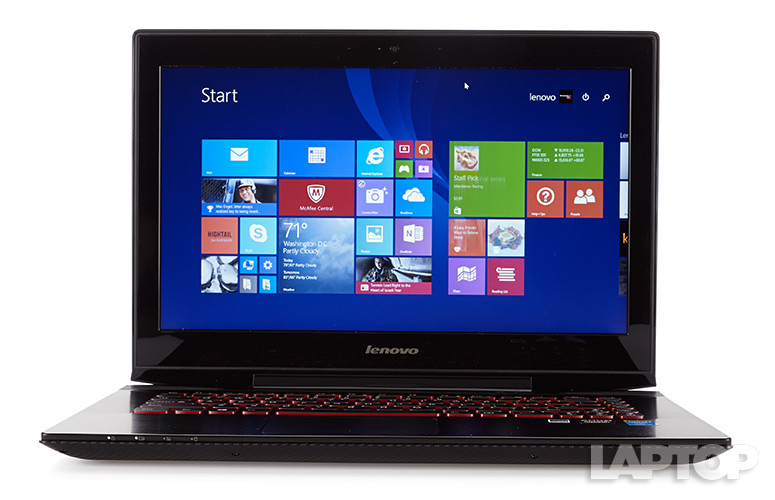
Click to EnlargeLenovo continues to impress me with its ability to offer gaming laptops at affordable prices. For $949, shoppers get a sleek-looking 14-inch notebook with solid overall performance and long battery life. However, while the AMD Radeon R9 M275 GPU isn't a lightweight, you won't be fragging or questing at the maximum settings. I also wish the notebook featured a better display and keyboard.
If you have (a lot) more money to spend, I recommend the MSI GS60 Ghost. That 15-inch system starts at $1,399 and boasts more muscular Nvidia graphics, a better display and a backlit, customizable keyboard. Overall, though, the Lenovo Y40 offers a fair amount of pep for its price.
How much portable gaming laptop can you get for less than a grand? Lenovo thinks it has the best answer yet with the Y40. Priced at $949 (starting at $749), this sleek and stylish notebook has long battery life and an AMD Radeon R9 graphics card for playing the latest titles. However, the lower-tier GPU forced me to settle for less-than-blistering frame rates, and the screen doesn't wow.
Design

The textured feel against my fingertips, the way the light undulates across the surface -- faux carbon-fiber chassis, you complete me. A pair of distinct, yet subtle lines that gradually recede into the top of the Y40's lid reminds me of a car hood; I love that it provides the feeling of peeling down a straightaway. There's not much flourish, but the glossy, dark-gray plastic Lenovo logo is a nice touch.
While the Y40's textured finish is lovely, the Razer Blade 14 remains my favorite 14-inch notebook in terms of design. The inky-black aluminum chassis manages to be striking yet subtle.
MORE: Find the Best Gaming Laptop for You
Upon opening the notebook, a layout similar to the larger Y50 greeted me. The majority of the deck is made of cool-to-the-touch, black brushed aluminum. The top of the deck is wrapped in shiny, black plastic flanked on either side by a black metal speaker grille with a red underlay. Buttons for power and Lenovo OneKey Recovery sit next to the right-side speaker.
At 4.4 pounds, the Y40 is fairly light, matching the Razer Blade 14 (2014). However the Blade 14 continues to be one of the slimmest in the land, measuring 13.6 x 9.3 x 0.7 inches, which is smaller than the Y40's 13.7 x 9.9 x 0.9-inch chassis. The MSI GS60 Ghost (4.2 pounds, 15.4 x 10.5 x 0.78 inches) is also lighter and thinner.
Display

Click to EnlargeSadly for a multimedia and gaming notebook, the Y40's 14-inch, 1920 x 1080-pixel anti-glare screen doesn't deliver the entertainment value I'd expect. According to our measurements, the panel is capable of displaying only 58.5 percent of the sRGB color gamut, which is well below the 86.4 percent thin-and-light average. The GS60 managed 98 percent, while the Blade 14 hit an impressive 101.5 percent.
On the Delta-E color accuracy test, the Y40 scored 8.8, which is far from a perfect 0. The Blade 14 came the closest to that mark at 1.5, while the GS60 scored 2.9.
Those underwhelming results help explain why colors fizzled on the Y40's display. The 1080p trailer for JIMI: All Is By My Side, which should have been an explosion of color, was lackluster at best. Andre 3000's skin looked washed out, while Hayley Atwell's red hair looked flat and lifeless. Viewing angles were monstrously shallow, with colors inverting at viewing angles of more than 45 degrees.
Things improved somewhat once I started gaming, as the deep greens, magentas and electric blues practically leapt off the panel as I played Borderlands 2. I particularly enjoyed watching enemies taking continuous damage from the bright-green radioactive goo that I shot at them. However, contrast was lacking in Metro: Last Light, as the Moscow subway system was a muddle of grays and blacks.
What the Y40 lacks in color and viewing angles, it makes up for in detail. I could see every wispy curl of Jimi's whimsical hairdo, along with the fine curlicues in his silk paisley shirt.
The laptop's display measured 200 nits on our light meter, falling short of the 216-nit average. The Blade 14 hit 260 nits, while the GS60 Ghost delivered a dazzling 299 nits.
Audio

Click to EnlargeThe Y40's JBL speakers pumped out big sound. Augmented by Dolby Digital Plus software, the pair of red-and-black speakers filled my small test room with crisp, punchy audio. Rosie Gaines' sophisticated alto in "I Can't Get You Outta My Mind" soared against the thumping bass line and crisp keyboard.
When measured for volume, the Y40 matched the thin-and-light average of 82 decibels. The GS60 was slightly louder, at 84 dB, but the Blade reached a higher 88 dB.
Keyboard and Touchpad

Click to EnlargeIt seems that the keyboard gods have forsaken Lenovo. The red-rimmed keys on the Y40's island-style keyboard have 1.3 mm of travel, falling short of the desired 1.5 to 2 mm range. I would normally overlook this drawback on a regular thin-and-light laptop, but not one targeting gamers.
In practice, the keys felt shallow, and some -- such as the Backspace and right Shift keys -- are undersized, making typing a chore. I eked out a paltry 46 words per minute on the Ten Thumbs Typing Test, which is well below my usual 55 wpm.
I was disappointed to learn that the Y40 lacked the backlighting found on the Y50's keyboard. The keyboard looks good, but aesthetics don't help when you're playing in a dimly lit setting.

Click to EnlargeI was happy to see that the Y40's 3.5 x 2.4-inch Elan touchpad provided a much better experience than the Y50. I typed without fear that my palm would accidentally graze the touchpad and launch a Windows 8 function.
I effortlessly performed such gestures as pinch-zoom, cycling between apps and two-finger rotate. The touchpad's bottom corners delivered firm feedback and served well as left and right mouse buttons.
MORE: The Best Gaming Keyboards You Can Buy
Heat
The Y40 is a cool customer, hitting only 81 degrees on the touchpad after I streamed a full-screen Hulu video for 15 minutes. That's much lower than our 95-degree comfort threshold. The space between the G and H keys registered 88 degrees, while the laptop's undercarriage was 87 degrees.
When I played Half-Life 2 for 15 minutes, the Y40's temperature rose considerably. The touchpad jumped to 90 degrees, while the space between the G and H keys measured 94 degrees. The bottom of the notebook hit 99 degrees. However, I used this system comfortably in my lap for more than 2 hours.
Webcam

Click to EnlargeIf you're looking for vibrant hues and crisp detail, keep looking. Photos taken with Y40's integrated 720p camera were relatively dark and full of visual noise. My normally eye-catching neon-green AKG Q701 headphones looked faded, as did the myriad shades of green in my shirt. My curled locks lacked definition, and looked more like blurry blobs.
At least you can have a little fun with your pics. Lenovo's Camera Man software lets you add different effects and filters, such as particles and distortion mirrors. My favorite option was the bubble effect that placed my image in a series of floating bubbles.
Ports

Click to EnlargeFor such a slim gaming laptop, the Y40 has a lot of ports. There's a single USB 2.0 port on the right with a 4-in-1 card reader, a combination headphone/microphone jack, a S/PDIF jack and a secure lock slot. The left side of the notebook has a pair of USB 3.0 ports, an HDMI port, an expandable Gigabit Ethernet slot and a proprietary power port.
Gaming and Graphics
Outfitted with the AMD Radeon R9 M275 GPU with 2GB of VRAM, the Lenovo Y40 offers decent graphics performance for the money. You'll be able to play demanding games such as BioShock Infinite and Titanfall -- just not at the highest settings.
Borderlands 2 ran smoothly on low at 1080p, but it exhibited some lag when I cranked it up to Maximum. It was more annoying than game-breaking, but there were a few occasions when an enemy got the drop on me due to a slow-moving reticle.
The laptop is also equipped with an Intel HD Graphics GPU to handle the light stuff like streaming video.
On the BioShock Infinite benchmark, the Y40 scored 38 frames per second on Low at 1080p, below the 53 fps average. The Razer Blade 14 hit a whopping 120 fps, while the MSI Ghost GS60 averaged 91 fps. To be fair, both the Blade and Ghost cost a much higher $2,399 and $1,799, respectively, and feature more powerful Nvidia GPUs.
MORE: 8 Essential Tips for Your New Windows 8 PC
On maximum settings playing the same game, the Y40's frame rate fell to 14 fps, missing the 21 fps category average. The Ghost obtained 35 fps, while the Blade 14 asserted its dominance at 65 fps.
On the 3DMark Ice Storm Unlimited benchmark, which also tests graphics performance, the Y40 hit 83,508. That was enough to topple the 60,275 thin-and-light average but not the Ghost (113,571) or Blade 14 (113,793).
Performance

Click to EnlargeBeneath the Lenovo Y40's stylish exterior lurk the capable components of a digital workhorse. The laptop's 1.8-GHz Intel Core i7-4500U CPU with 8GB of RAM ably streamed an episode of The Boondocks on Netflix with eight open windows in Google Chrome while performing a full system scan.
During Geekbench 3, which measures overall performance, the Y40 scored 5,537, missing the 5,823 thin-and-light average. The 2.4-GHz Intel Core i7-4700HQ-powered MSI GS60 Ghost notched 12,695, while the Razer Blade 14 and its 2.2-GHz Intel Core i7-4702HQ CPU obtained 11,497.
On the File Transfer Test, the Y40's Lite-On 256GB SSD duplicated 4.97GB of multimedia files in 2 minutes and 10 seconds, for a transfer rate of 39.1 MBps. That's well below the 107.2 MBps average, and very slow for an SSD.
When the Y40 ran the spreadsheet performance test, it paired 20,000 names and addresses in 4 minutes and 33 seconds. That's nearly 2 minutes faster than the 6:23 average.
Battery Life

Click to EnlargeOne area where the Lenovo Y40 bested its more expensive counterparts is in the endurance department. On the Laptop Mag Battery Test (continuous Web surfing over Wi-Fi at 100 nits), the Y40 lasted 7 hours and 34 minutes, matching the thin-and-light average. The Blade 14 finished in 5:19, while the GS60 Ghost clocked out at 5:34.
MORE: 10 Laptops with the Longest Battery Life
Software and Warranty

Click to EnlargeLenovo preinstalled a fairly robust suite of utilities, including Lenovo Companion, which has the Getting Started Guide, App Showcase and other helpful links. Lenovo Support provides links to a User Guide, Hints and Tips, Knowledge Base, and Discussion Forum. OneKey Recovery System allows you to create a backup image file of your hard drive in case of a crash. The Settings app compiles important settings (Wi-Fi, Airplane Mode, Microphone, Keyboard LED and Touchpad) into an easy-to-use control panel.
Hoping to attract heavy-multimedia users, the Y40 comes with CyberPower's PhotoDirector 3 and MediaStory software, which let you edit images and create slideshows, respectively.
Even though I wouldn't know my way around a sound mixing board, I had fun creating music with the SoundLight software. Using pre-recorded tracks, including a hip-hop bass line, I cobbled together a danceable ditty. And because sometimes you just gotta sing, Lenovo has also included the Red Karaoke Lenovo app.
Third-party software includes eBay, Accuweather.com, Evernote Touch, Zinio Reader, Kindle and FilmonTV, a streaming channel that features more than 600 channels of live television and movies.
File Sharing
To complement its content-creation software, the Y40 has several file-sharing options for sharing your stuff across several devices. Hightail for Lenovo lets you upload files and folders to the cloud so you can share and access them from anywhere. Exclusive to Lenovo users, Hightail offers 5GB of free storage.
If that isn't enough file-sharing goodness for you, the company offers Lenovo Reach, which includes a file manager, app selector and website manager. Similar to Hightail, Reach can be accessed on any device, including iOS, Android and Windows Phone.
Lenovo's Magic Transfer software lets you transfer files between laptops by dragging and dropping via the touch screen. Once the laptops are connected to a local network, it's a simple flick of the wrist -- at least it would have been if the Y40 had been equipped with a touch screen. Instead, I was relegated to doing it the old-fashioned way, by using the mouse. Still, it took a relatively quick 3 seconds to transfer individual docs and music files.
Lenovo Phone Companion

Click to EnlargeSimilar to the Y50, the Y40 features the Phone Companion app (free on Android, iOS and Windows Phone), which syncs the PC with your smartphone over a local network and lets you place calls, send text messages and swap content between the two devices.
However, the setup is rather tedious. After scanning a QR code with my Samsung Galaxy S4 and installing the app, I made sure that the notebook and the S4 were on the same local network.
From there, I hit the Connect button and waited … and waited. About 2 minutes later, the two systems found each other, and it took another 3 minutes to pull up my contacts, pictures, video and call history.
It was pretty straightforward to browse through my contacts and photo gallery. Sending and receiving text was quick, with responses on the PC showing up a few seconds after they hit the phone. While you can place and receive calls on the PC, you still have to use the phone to talk.
Overall, it's a solid concept, but I hope Lenovo plans to just place the app in the app stores instead of making people download QR scanners just to install the program.
Configurations
The Lenovo Y40 I reviewed was configured with a 1.8-GHz Intel Core i7-4500U CPU, which has since been upgraded to a 2-GHz Intel Core i7-4510U processor. The rest of the specs in the $949 device remained the same, including 8GB of RAM, a 256GB SSD, an Intel HD Graphics GPU and an AMD Radeon R9 M275 GPU with 2GB of VRAM.
The $749 base model features a 2-GHz Intel Core i7-4510U, 8GB of RAM and a 500GB, 5,400 RPM hard drive paired with an 8GB SSD. You also get Intel HD Graphics and an AMD Radeon R9 M275 GPU with 2GB of VRAM.
The $1,349 configuration has a 2-GHz Intel Core i7-4510U; 8GB of RAM; a 1TB, 5,400 RPM hard drive with an 8GB SSD; Intel HD Graphics; and an AMD Radeon R9 M275 GPU with 2GB of VRAM.
The Lenovo Y40 comes with a one-year parts-and-labor warranty.
Bottom Line

Click to EnlargeLenovo continues to impress me with its ability to offer gaming laptops at affordable prices. For $949, shoppers get a sleek-looking 14-inch notebook with solid overall performance and long battery life. However, while the AMD Radeon R9 M275 GPU isn't a lightweight, you won't be fragging or questing at the maximum settings. I also wish the notebook featured a better display and keyboard.
If you have (a lot) more money to spend, I recommend the MSI GS60 Ghost. That 15-inch system starts at $1,399 and boasts more muscular Nvidia graphics, a better display and a backlit, customizable keyboard. Overall, though, the Lenovo Y40 offers a fair amount of pep for its price.
Lenovo Y40 Specs
| Bluetooth | Bluetooth 4.0 |
| Brand | Lenovo |
| CPU | 1.8-GHz Intel Core i7-4500U |
| Card Slots | 4-1 card reader |
| Company Website | www.lenovo.com |
| Display Size | 14 |
| Graphics Card | AMD Radeon R9 M275/Intel HD Graphics Family |
| Hard Drive Size | 256GB |
| Hard Drive Speed | n/a |
| Hard Drive Type | SSD Drive |
| Native Resolution | 1920x1080 |
| Operating System | Windows 8.1 |
| Optical Drive | None |
| Optical Drive Speed | n/a |
| Ports (excluding USB) | S/PDIF, HDMI, Gigabit Ethernet, Combo Headphone/Mic Jack, security lock slot, USB 3.0, USB 2.0 |
| RAM | 8GB |
| RAM Upgradable to | 16GB |
| Size | 13.7 x 9.8 x 0.9 inches |
| Touchpad Size | 3.5 x 2.4 inches |
| USB Ports | 3 |
| Video Memory | 2GB |
| Warranty/Support | One year limited warranty |
| Weight | 4.4 pounds |
| Wi-Fi | 802.11ac |
| Wi-Fi Model | Intel Dual Band Wireless-AC 3160 |

Sherri L. Smith has been cranking out product reviews for Laptopmag.com since 2011. In that time, she's reviewed more than her share of laptops, tablets, smartphones and everything in between. The resident gamer and audio junkie, Sherri was previously a managing editor for Black Web 2.0 and contributed to BET.Com and Popgadget.
